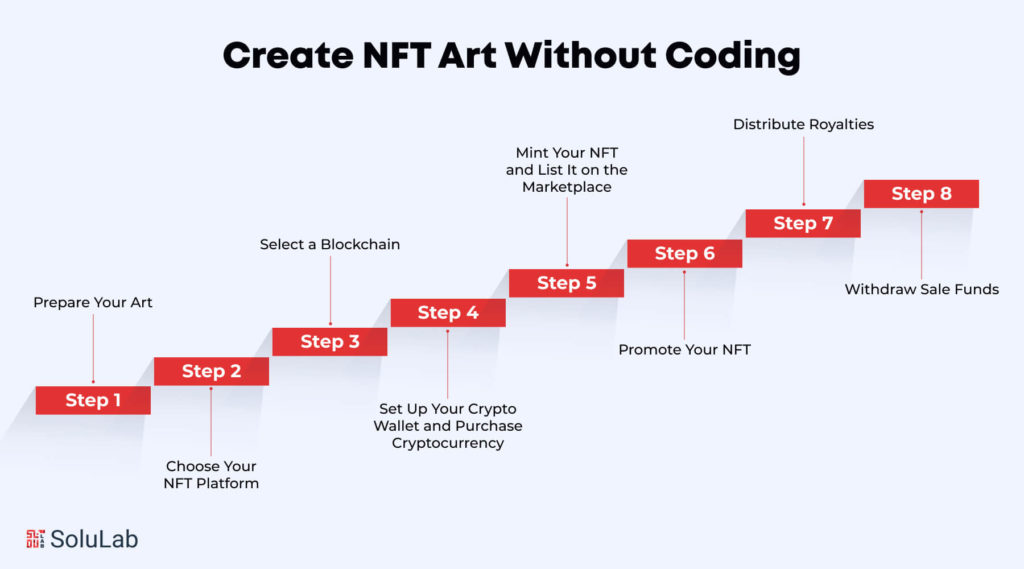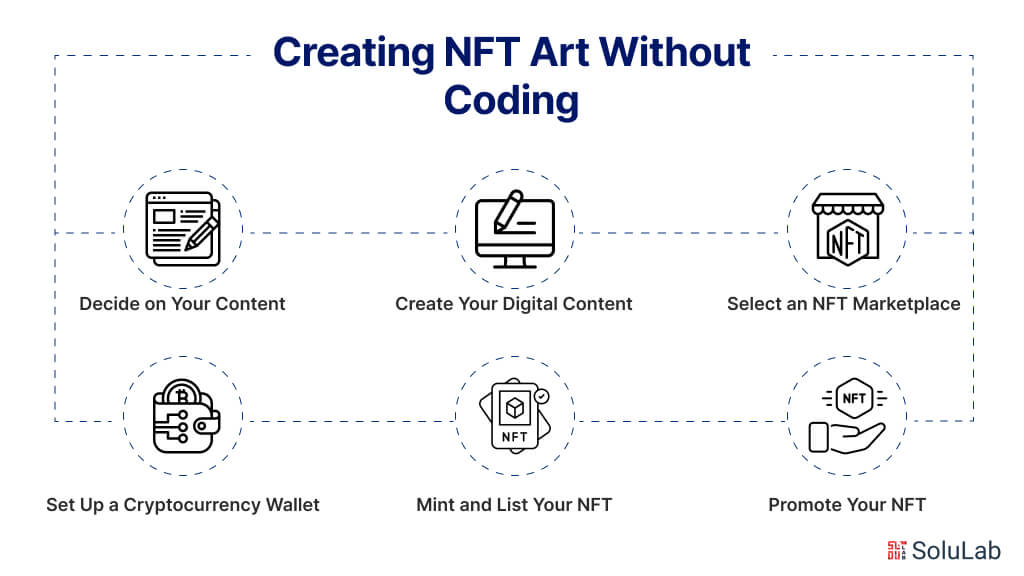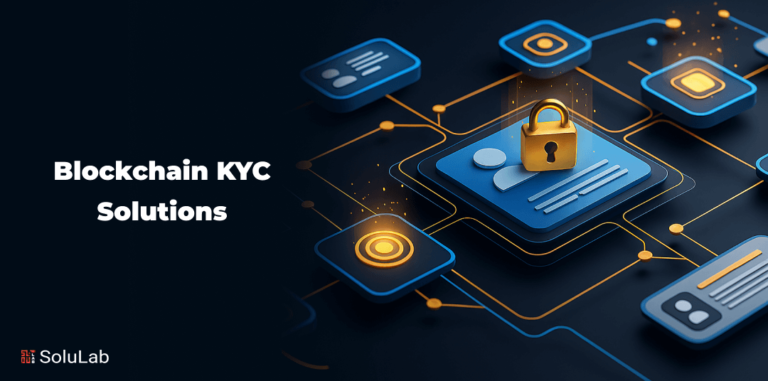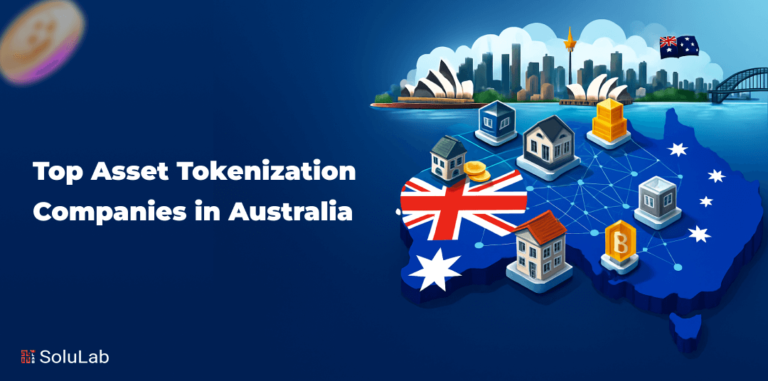
Non-fungible tokens, or NFTs, have lately altered the idea of digital ownership. Non-fungible tokens, or NFTs for short, have gained immense popularity in recent years, especially NFT art. To produce distinctive digital assets that indicate ownership of virtual goods like artwork, collectibles, and in-game items, NFTs use blockchain technology. This has opened up a whole new market for creativity and digital scarcity, giving artists and content producers a new way to make money off of their creations.
We shall discuss the idea of NFTs and how they vary from other digital files in this blog. We will also talk about the many types and challenges that come with this concept. Finally, this blog will also help you understand how to create NFT Art without coding.
By the time you’re done, you’ll know what makes NFTs special, how to build your own no-code NFT and some of the trade-offs you should consider before entering this quickly developing digital products sector. Let’s start investigating non-fungible tokens and the potential future they might contribute to.
What is an NFT Art?
A piece of information used to identify distinct digital assets that are not exchangeable is called a non-fungible token (NFT). It is updated using an electronic ledger called a blockchain. NFTs can be used to depict many digital media types, such as video and music. They could also represent actual objects, such as works of art or real land. Because each NFT is unique from others of its sort and cannot be utilized together, digital scarcity and value are created. Unlike cryptocurrencies, which are fungible (interchangeable) tokens meant to be exchanged, NFTs are meant to be collected and owned. A number of variables, such as novelty, market demand, and connection to the real world, affect an NFT’s value.
NFTs use blockchain technology to assign ownership rights and maintain a secure public record of transactions. By enabling content creators to conduct direct sales to consumers, they circumvent traditional gatekeepers.
Types of NFTs
Non-fungible tokens (NFTs) have rapidly grown in popularity, encompassing a wide array of digital assets. Here’s a breakdown of the main types of NFTs:
1. Art
NFT digital art includes digital paintings, illustrations, and 3D renderings. Artists mint their works as NFTs to ensure authenticity and earn royalties. Notable examples include Beeple’s “Everyday: The First 5000 Days” and works by creators on platforms like SuperRare and Foundation.
2. Collectibles
Digital collectibles are unique items that are often part of larger sets, akin to digital trading cards. Projects like CryptoPunks and Bored Ape Yacht Club offer limited editions that have become highly sought after. These collectibles often include special features or attributes that enhance their rarity and value.
3. Gaming
NFTs in gaming represent in-game assets such as characters, weapons, or virtual land. These assets can be traded or sold across different games or platforms. Axie Infinity and Decentraland are prominent examples, where players can buy, sell, and trade game assets freely.
4. Virtual Real Estate
Virtual real estate involves the ownership of digital land or properties in virtual worlds. These can be used for creating experiences, virtual stores, or social spaces. Platforms like Decentraland, The Sandbox, and Cryptovoxels offer opportunities to invest in and develop virtual properties.
5. Music
Musicians use NFTs to sell their music, albums, or exclusive content directly to fans. This method provides artists with a new revenue stream and closer interaction with their audience. Kings of Leon’s album “When You See Yourself” and exclusive releases on platforms like Audius exemplify this trend.
6. Sports Memorabilia
NFTs are revolutionizing sports collectibles by digitizing memorabilia such as trading cards, highlight clips, and other exclusive content. NBA Top Shot, which sells officially licensed NBA highlight clips as NFTs, is a notable example, allowing fans to own a piece of sports history.
7. Domain Names
Blockchain-based domain names, represented as NFTs, offer decentralized control over domain registration. Platforms like Unstoppable Domains and Ethereum Name Service (ENS) provide domain names that can be securely bought, sold, and managed without intermediaries.
8. Fashion
Fashion NFTs include digital clothing, accessories, and virtual fashion items. These can be worn by avatars in virtual environments or collected as digital assets. Brands like Gucci and Nike have entered the NFT space, creating unique fashion pieces and experiences.
9. Utility NFTs
Utility NFTs provide holders with specific benefits or access to services. These might include membership passes, event tickets, or other types of digital keys that grant access to exclusive content or experiences. For example, NFT-based memberships can provide access to exclusive online communities or real-world events.
10. Photography
Photographers mint their digital photos as NFTs to authenticate their work and reach new markets. NFT platforms dedicated to photography, such as Quantum Art and Sloika, enable photographers to sell their works directly to collectors.
The NFT marketplace platform continues to evolve, with new types and applications emerging as technology and creativity push the boundaries of what’s possible in the digital world. Each type of NFT brings unique benefits and opportunities, catering to diverse interests and industries.
New Types of Ownership for Art
NFTs make feasible new forms of art ownership for digital creations that were before unimaginable. NFTs efficiently establish scarcity and ownership rights for previously readily copied and disseminated digital artworks by tokenizing them. Through the blockchain, artists may now demonstrate the legitimacy and ownership of their digital collections. Every NFT art for beginners has an unquestionable history of who had it at any given period.
Furthermore, artists have the option to create smart contracts to give them royalties on any upcoming subsequent sales of their NFT artwork. The NFT has a “resale rights clause” that grants artists a portion of the proceeds each time their creation is sold. This idea was not formerly relevant to digital art. NFTs have also enabled collaborative art by allowing several artists to obtain partial ownership of a single piece of art with the use of shared tokens. All things considered, NFTs have revolutionized digital art by bringing to the virtual sphere the essential characteristics of actual art: authenticity, exclusivity, verified ownership, and resale value. Many digital artists have had tremendous success as a result of this change.
Reasons Behind No-Code NFT Art Creation
If your artwork is selling for outstanding rates, you could be doing well as an artist. It might be difficult to perceive any possible advantages for investing in NFTs and digital assets in general in light of this. It doesn’t imply they aren’t there, though, just because you can’t think of them right now. Here are a couple of such instances.
-
Lifelong Royalties
In the past, artists have made very little money over their lives since the value of the work they create and sell increases with time. Therefore, resellers—those who purchase artwork from artists and resell it to others—are the ones who benefit the most financially. Even in situations where their prior work is valued in the millions, artists have passed away in poverty. For musicians and other artists, this could have altered in the modern day, but for those who paint and draw, things stay the same. Investing in non-fungible tokens helps to mitigate some of the risks, and you can keep receiving royalties for the rest of your life rather than just receiving a lump sum payment when you sell the artwork.
All it takes to secure a lifetime of income is to include royalties in the artwork. Notably, NFT royalties can range from 2.5% to 10%. If your work’s future value increases for whatever reason, you may be in for several lucrative payouts.
-
More Reasonable to Begin
Additionally, artists usually have to handle the financial aspects of selling their artwork. This frequently entails leasing a gallery, covering the cost of auction house services, and perhaps even transportation to the buyer’s home. With NFTs, you don’t have to be concerned about these concerns.
They are accessible worldwide and sold in peer-to-peer internet markets. By doing so, you increase the number of possible purchasers and retain the majority of the sale’s revenues.
-
Genuine and Verifiable
In earlier eras, determining the authenticity of an artwork has also been an issue for art sales. With NFTs, you can rest easy knowing that your artwork is authenticated and may be downloaded or linked to by others.
Notably, the authenticity certificate includes details about the artist, previous owners, and purchase costs. You and the NFT purchasers can always monitor where the money goes and who owns it with that level of transparency and verifiability.
How to Create NFT Art Without Coding: Step-by-Step Guide
Creating NFT for free is easier than you might think, and you don’t need any coding skills to get started. With some basic tools and a few simple steps, you can mint and sell your digital artwork as an NFT. This section will walk you through the process of how to create NFT art without coding.
Step 1: Prepare Your Art
For no-code NFT art creation, start by preparing your digital artwork. This might be a digital collectible such as an image, video, audio file, or any other form of digital content. Ensure your artwork is of high quality and uniquely yours, as originality and quality will attract potential buyers.
Step 2: Choose Your NFT Platform
Next, select an NFT marketplace to list your NFT. Popular choices include Foundation, Rarible, SuperRare, OpenSea, and Nifty Gateway. Each platform has its own unique features and fee structures, so choose the one that best fits your needs.
Step 3: Select a Blockchain
Decide on the blockchain you want to use for minting your NFT. Ethereum is the most popular option due to its widespread adoption and support. However, other blockchains like Binance Smart Chain and Flow are also viable options depending on your preferences and the platform you choose.
Step 4: Set Up Your Crypto Wallet and Purchase Cryptocurrency
You will need a cryptocurrency wallet to store the funds required to mint your NFT and to receive payments from sales. Popular wallets include MetaMask and Coinbase Wallet. Once your wallet is set up, purchase some Ethereum (ETH) or the blockchain’s native currency to cover the minting fees.
Step 5: Mint Your NFT and List It on the Marketplace
Follow the platform’s instructions to mint your NFT. This usually involves uploading your digital art, setting options like the name, description, and number of copies, and paying the minting fee in ETH. Once minted, your NFT will be listed on the marketplace for sale.
Step 6: Promote Your NFT
After your NFT is listed, promote it to attract buyers. Use social media platforms such as Twitter, Instagram, and specialized NFT communities to spread the word. Effective promotion is key to ensuring that your NFT reaches potential buyers.
Related: Twitter NFT; First Social Media Platform to Support NFT Technology
Step 7: Distribute Royalties
If you have set up a royalty scheme within your NFT’s smart contract, you will receive a percentage of the sales each time your NFT is resold. This feature ensures you continue to benefit from future transactions involving your artwork.
Step 8: Withdraw Sale Funds
As your NFT sells, you can withdraw the proceeds from your crypto wallet to your bank account. Use a cryptocurrency exchange to convert ETH to your local currency if needed.
Creating NFT Art Without Coding

Creating NFT art without coding is straightforward and accessible. Here’s a recap of the essential steps:
-
Decide on Your Content
Choose the type of content you want to turn into an NFT. This could be a digital photo, video clip, song, or any other original artwork. Ensure that the content is solely owned by you and that you have the right to sell it.
-
Create Your Digital Content
Use common editing tools to create your digital artwork. For photos, tools like Photoshop or Canva are excellent. For videos, try iMovie or Adobe Premiere Pro. For audio, Audacity is a great option for recording and editing. High-quality content is crucial for attracting potential buyers.
-
Select an NFT Marketplace
Sign up on an NFT marketplace such as OpenSea, Rarible, Foundation, or Nifty Gateway. Create a free account and verify your identity to start listing your NFTs.
-
Set Up a Cryptocurrency Wallet
Download a cryptocurrency wallet like MetaMask or Coinbase Wallet. Create an account and store some Ethereum (ETH) or the relevant blockchain currency to cover minting fees.
-
Mint and List Your NFT
Mint your NFT by uploading your digital content to the chosen marketplace. Provide a name, and description, and set your price in ETH. The marketplace will create a unique token linked to your artwork and list it for sale.
-
Promote Your NFT
Share your NFT on social media platforms and within NFT communities to drive interest and sales. If your NFT doesn’t sell quickly, consider adjusting the price or enhancing your promotional efforts.
Creating NFT art without coding is a straightforward process that involves preparing your content, selecting the right tools and platforms, and effectively promoting your work. With persistence and the right approach, you can successfully create NFT art and reach a global audience.
Impacts and Challenges While Creating NFT Art Without Coding
The following are a few impacts and challenges of creating NFTs:
Positive Impacts:
- Direct monetization: Direct monetization of work without middlemen is now possible for content providers, including musicians, artists, and collectors, thanks to NFTs.
- Democratizing wealth: More varied perspectives are being heard because to the NFT market, which has witnessed tremendous success for up-and-coming musicians.
- Encouraging innovation: New business concepts, financial products, and artistic mediums have all been inspired by the NFT sector.
- Provenance: To help establish the legitimacy and value of NFTs, the blockchain provides an immutable record of ownership and provenance.
Challenges:
- Environmental Impact: Minting and trading NFTs on the Ethereum network requires significant energy consumption, which raises sustainability issues.
- Speculative Bubble: There are worries that the present NFT frenzy is more like a speculative bubble, with excitement driving value rather than substance.
- Fraud and Theft: Because there are no consumer safeguards in place, there have been instances of NFT fraud, scams, and theft, as with any new technology.
- Volatility: NFTs are a dangerous investment since their value is directly correlated with the cryptocurrency’s price volatility.
- Unregulated Market: There is no monitoring and no consumer protection in the still-developing unregulated NFT sector.
Top NFT Marketplaces for Beginners
It might be difficult for novices to find their way around the several NFT markets that are accessible. Let’s examine a few of the available marketplaces and talk about why they could be the best fit for you.
1. OpenSea: For good reason, OpenSea is among the most well-liked NFT marketplaces. It is simple to use and lets users purchase and sell NFTs with a variety of cryptocurrencies. There is something for everyone on OpenSea, as they also provide a large selection of digital art for purchase. OpenSea is a fantastic place to start if you’re new to NFTs.
2. SuperRare: SuperRare is a hand-picked NFT marketplace with an emphasis on distinctive, premium digital art. Though its user base is lower than that of other markets, it is renowned for its uniqueness and quality. SuperRare is an excellent venue to display your skills if you’re an artist trying to sell your pieces as NFTs.
3. Foundation: The foundation operates a well-known NFT market for digital items and art. It is a wonderful spot to start selling your NFTs because of its vast user base and easy-to-use layout. Additionally, the Foundation boasts a robust artist and collector community that may aid in drawing attention to your artwork.
4. Rarible: A decentralized NFT marketplace called Rarible enables users to produce and trade their NFTs. It’s a fantastic choice for newcomers because of its user-friendly layout and affordable prices. Additionally, Rarible boasts a vibrant creator and collector community that might aid in drawing attention to your work.
5. Nifty Gateway: A user-friendly NFT marketplace, Nifty Gateway specializes in limited edition releases from well-known and well-liked musicians. Artists wishing to sell their work as NFTs will find it to be a great venue because of its reputation for premium artwork and uniqueness. Collectors may buy NFTs with a credit card on this user-friendly portal. Additionally, Nifty Gateway provides events and a vibrant network for artists and collectors.
Conclusion
Creating NFT art without coding has opened up new opportunities for artists and creators to monetize their digital work in the burgeoning blockchain ecosystem. By following simple steps—preparing your art, choosing a platform, setting up a crypto wallet, minting your NFT, and promoting it—you can successfully enter the NFT marketplace. This process democratizes access to the digital art market, allowing more people to benefit from the growing interest in non-fungible tokens.
However, despite the simplified process, creators often face challenges such as understanding the complexities of blockchain technology, navigating various NFT platforms, and effectively marketing their NFTs to reach potential buyers. This is where SoluLab, a leading NFT development company, can provide valuable assistance. SoluLab offers comprehensive NFT marketplace development services, helping artists overcome technical barriers and maximize their success in the NFT space. With expertise in blockchain development and a deep understanding of the NFT market, SoluLab can guide you through the entire process, from minting to marketing. Ready to elevate your NFT journey? Contact SoluLab today and turn your digital art into valuable assets.
FAQs
1. What is an NFT and how does it differ from other digital assets?
An NFT, or Non-Fungible Token, is a unique digital asset stored on a blockchain, representing ownership of a specific item like digital art, music, or collectibles. Unlike cryptocurrencies such as Bitcoin or Ethereum, which are fungible and can be exchanged on a one-to-one basis, NFTs are unique and cannot be exchanged like-for-like. Each NFT has distinct information and ownership proof, making it one-of-a-kind.
2. Do I need to know how to code to create NFT art?
No, you don’t need to know how to code to create NFT art. Many user-friendly platforms like OpenSea, Rarible, Foundation, and SuperRare allow you to mint NFTs using simple, guided steps. These platforms handle the technical aspects, enabling you to focus on your art and its promotion.
3. What are the costs involved in creating and selling NFT art?
Creating and selling NFT art involves several potential costs, primarily related to minting fees (gas fees) on the blockchain, platform listing fees, and transaction fees for sales. The costs can vary based on the blockchain you use (Ethereum, Binance Smart Chain, etc.) and the specific marketplace. It’s essential to factor in these costs when pricing your NFT.
4. How can I promote my NFT art to attract buyers?
To promote your NFT art, leverage social media platforms such as Twitter, Instagram, and TikTok. Join NFT and crypto communities on Discord and Reddit, and engage with potential buyers by sharing your creation process, the story behind the art, and the unique aspects of your NFT. Collaborating with other artists and participating in virtual NFT events can also boost your visibility.
5. What challenges might I face when creating NFT art without coding, and how can SoluLab help?
Creators might face challenges such as understanding blockchain technology, choosing the right platform, handling minting fees, and effectively marketing their NFTs. SoluLab, a leading NFT development company, can help overcome these hurdles by providing expert guidance and comprehensive NFT development services. SoluLab’s team can assist with technical aspects, marketing strategies, and maximizing the potential of your NFTs.






